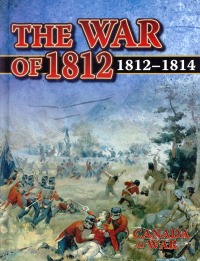| ________________
CM . . . . Volume XVIII Number 22 . . . . February 10, 2012
excerpt:
Part of the four-title "Canada at War" series, The War of 1812 focuses on the events leading up to the War of 1812, the various battles fought, and the war's aftermath. The book, numbering 17 chapters, begins with an overview of Canada's involvement in various conflicts. On June 18, 1812, the United States declared war on Great Britain. This was the result of a number of issues, particularly the British naval blockade which prevented cargo ships bound for America from leaving Europe, and the conflict between a newly-emerging country and an established empire. The war took place on land, on the Atlantic Ocean and the Gulf of Mexico, but the key battle sites were mainly around Lake Erie. Important battles included the Battle of Detroit and the Battle of Queenston Heights in 1812, and the Battle of Châteaugay in 1813. Each of these battles is discussed in detail as are the contributions of heroes, such as Laura Secord, Robert Barclay, Isaac Brock and Charles de Salaberry. One especially interesting aspect of the book is the description of a soldier's life. There is information about the parts of a soldier's uniform, his weapons (swords, sabers, rifles, flintlock muskets, mortars, cannons and howitzers), and the hardships that soldiers had to endure. Some of these hardships include inclement weather, disease, poor food and not having enough to eat, and a monotonous diet. There is also information about the life of a settler with respect to his home and farm as well as a description of the colonial government of British North America. Settlers' planting and harvesting efforts often went awry as battles were sometimes fought in farmers' fields. One such case was a conflict in November, 1813, on John Crysler's farm. Though the battle was only a few hours long, many bodies of American soldiers were strewn across his fields, ruining the wheat crop. On December 24, 1814, the war ended with the signing of the Treaty of Ghent. As with any conflict, there were both positive and negative results. Aboriginal people were encouraged to move onto reserves, farm the land and become Christians. This had far-reaching consequences which linger to the present day. But the war also had economic benefits, specifically the rebuilding of forts, and the development of the shipbuilding industry and fishing industries. The remainder of the book provides war statistics and also features the various monuments commemorating the contributions of several people, one example being Brock's Monument which is located at Queenston Heights National Historic Site. There is a timeline, a quiz with multiple choice, true/false and mix and match questions, and a research activity which asks readers to examine events that prevented the U.S. from winning the war, with specific reference to the number of soldiers per side, military organization and war strategies and the contributions of civilians. A table of contents, a glossary and an index are provided. Illustrations are many and varied. They include maps, charts, pie graphs, drawings, paintings and colour photographs, all of which serve to give readers a better sense of the events and the people who were involved. Recommended. Gail Hamilton is a former teacher-librarian in Winnipeg, MB.
To comment
on this title or this review, send mail to cm@umanitoba.ca.
Copyright © the Manitoba Library Association. Reproduction for personal
use is permitted only if this copyright notice is maintained. Any
other reproduction is prohibited without permission.
NEXT REVIEW |
TABLE OF CONTENTS FOR THIS ISSUE
- February 10, 2012.
AUTHORS |
TITLES |
MEDIA REVIEWS |
PROFILES |
BACK ISSUES |
SEARCH |
CMARCHIVE |
HOME |
